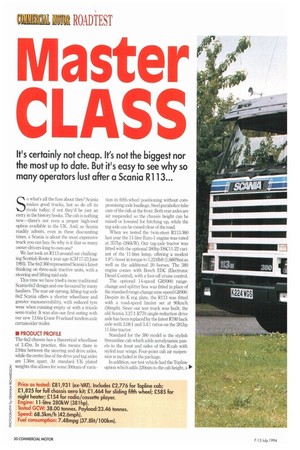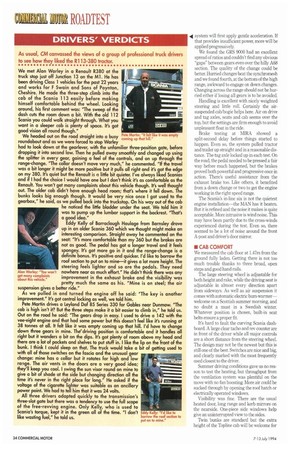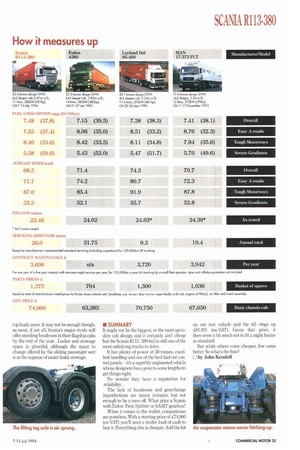Master CLASS
Page 32

Page 34

Page 36

Page 37

If you've noticed an error in this article please click here to report it so we can fix it.
It's certainly not cheap. It's not the biggest nor the most up to date. But it's easy to see why so many operators lust after a Scania R1 13...
So what's all the fuss about then? Scan in makes good trucks, but so do all its rivals today; if not they'd be just an entry in the history books. The cab is nothing new—there's not even a proper high-roof option available in the UK. And, as Scania readily admits, even in these discounting times, a Scania is about the most expensive truck you can buy. So why is it that so many owner-drivers long to own one?
We last took an R113 around our challenging Scottish Route a year ago (CM17-23 June 1993). The 6x2 360 represented Scania's latest thinking on three-axle tractive units, with a steering and lifting mid-axle.
This time we have tried a more traditional Scania 6x2 design and one favoured by many hauliers. The rear-air-sprung, lifting-tag-axle 6x2 Scania offers a shorter wheelbase and greater manoeuvrability with reduced tyre wear when running empty or with a triaxle semi-trailer, It was also our first outing with our new 116m Crane Fruehauf tandem-axle curtainsider trailer.
• PRODUCT PROFILE The 6x2 chassis has a theoretical wheelbase of 347m. In practice, this means there is 2.94m between the steering and drive axles, while the centre line of the drive and tag axles are 1.36m apart. At standard UK plated weights this allows for some 300mm of varia tion in fifth-wheel positioning without compromising axle loadings. Steel parabolics take care of the ride at the front. Both rear axles are air suspended so the chassis height can be raised or lowered for hitching up, while the tag axle can be raised clear of the road.
When we tested the twin-steer R113-360 last year the 11-litre Euro4 engine was rated at 357hp (266kW). Our tag-axle tractor was fitted with the optional 380hp DSC11-22 variant of the 11-litre lump, offering a modest 1.8% boost in torque to 1,2241bft (1,660Nm) as well as the additional 20 horses. The 380 engine comes with Bosch EDC (Electronic Diesel Control), with a foot-off cruise control.
The optional 14-speed GRS900 rangechange and splitter box was fitted in place of the standard range-change nine-speed GR900. Despite its K reg plate, the R113 was fitted with a road-speed limiter set at 901crn/h (56mph). Since our test truck was built, the old Scania 3.27:1 R770 single-reduction drive axle has been replaced by the latest R780 back axle with 3.08:1 and 3.4;1 ratios on the 381hp 11-litre tractor.
Standard for the 380 model is the stylish Streamline cab which adds aerodynamic panels to the front and sides of the R-cab with styled rear wings. Four-point cab air suspension is included in the package.
In addition, our test vehicle had the Topline option which adds 220mm to the cab height, a trip meter/outside temperature gauge, air-suspended passenger seat (which slides back against the cab rear wall), seat-mounted seatbelts, headlamp wash/wipe and central locking. It certainly enhances the Scania R cab's looks but the Topline package adds £2,776 to the 380 chassis price.
• PRODUCTIVITY The Scania is one of the first 38-tonners we have taken around our Scottish route with a 901cm/h (56mph) speed limiter. One argument says it should help fuel consumption; another says the gains are lost with less momentum in hillclimbing. A glance at our selected rivals shows that this is the case—our R113-380 came out marginally best on fuel with a useful overall figure of 748mpg (37.81ft/100km). But it was also the slowest contender overall, recording an average speed of 68.51cm/h. However, it was not the slowest over our hilly "tough motorway" section where outright grunt helps.
While the overall fuel consumption figure is certainly creditable, we expected better still after the first day's result—average fuel consumption 8.32mpg (34.01it/100km). The culprit was not the truck but the variable British weather. In light airs, the Scania should have recorded a figure similar to the MAN 19372 over the easy A-road section (8.76mpg, 32.31it/100km). Strong cross-winds experienced on the second and third days, crunched this figure down to 7.55mpg (37.4lit/1001cm). The hill-climb results and track acceleration times at IVIIRA are a good indicator of outright performance potential. Here the Scania kept ahead of most rivals on the track and returned some good hill-climb times, notably Black Hill, which it polished off quicker than all our listed rivals. All results were no doubt helped by a well-run-in engine. Our R113, fresh from the Scania demo fleet had racked up some 118,000Iun.
The Topline Streamline cab with its raised roof and high specification does not help the weight. At 8.04 tonnes it's some 300kg heavier than the R113 twin-steer tested last year with the standard cab. Foden's 4380 6x2 weighs in at almost 600kg less.
At least it should not spend too much time in the service bay. Scania reckons on a competitive 26 hours for routine servicing in its first year, falling to 24 in subsequent years.
Parts prices appear generally reasonable, although Scania's claim that a complete driver's door mirror costs just £18.16 might raise a few eyebrows. It's also worth noting that asbestos-free brake linings will set you back £490 on exchange, compared with £394 for those containing the nasty material.
• ON THE ROAD The test proved more than just the truck Our regular fuelling point at the start of our route on the AS near Hinckley closed for re-furbishment last year. In the process it changed hands from Q8 to the Heron Group. We checked with the company at the time to see if we would be able to continue using the site and were assured the canopy would still accommodate a full-height trailer.
It therefore came as some surprise to find that the canopy was only 3.8m tall. Our thanks to the Mercedes driver who held up the traffic in both directions on the AS while we backed out again. We understand that the canopy is going to be raised let's hope the Iieron Group keeps to it this time.
The delay cost us over an hour while we fuelled elsewhere then returned to our start point to take the necessary readings. At least the reversing exercise helped us to appreciate the manoeuvrability of the tag-axle Scania.
Out on the open road we could see why drivers like the big Scania. In 380hp guise, the 11litre six combines good power and torque. EDC helps to iron out the torque curve between about 1,000rpm and 1,500rpm, making it a flexible engine and keeps gear changes to the minimum.
EDC's add-on cruise control also deserves high praise. Two rocker switches to the right of the steering wheel control the system. The speed is set with the accelerate/retard switch which can also be used to adjust the speed. The system's memory retains the last selected speed and can be called up with the "RES" setting of the second switch. Pushing the rocker switch the other way turns the system off. Operating the clutch or brake also cancels it. If the speed drops below that selected, the ■ system will first apply gentle acceleration. If that provides insufficient power, more will be applied progressively.
We found the GRS 9000 had an excellent spread of ratios and couldn't find any obvious "gaps" between gears even over the hilly A68 section. The quality of the change could be better. Hurried changes beat the synchromesh and we found fourth, at the bottom of the high range, awkward to engage on down changes. Changing across the range should not be hurried either if losing all gears is to be avoided.
Handling is excellent with nicely weighted steering and little roll. Certainly the airsuspended cab/bogie helps here. Air on drive and tag axles, seats and cab seems over the top, but the settings are firm enough to avoid unpleasant float in the ride.
Brake testing at MIRA showed a split-second delay before things started to happen. Even so, the system pulled tractor and trailer up straight and in a reasonable distance. The tag axle locked up in each test. On the road, the pedal needed to be pressed a fair way before much happened, but the brakes proved both powerful and progressive once in action. There's useful assistance from the exhaust brake too. Like others, it benefited from a down change or two to get the engine working in the right speed range.
The Scania's in-line six is not the quietest engine installation—the MAN has it beaten. But it is refined and the noise it makes is quite acceptable. More intrusive is wind noise. This may have been partly due to the cross-winds experienced during the test. Even so, there seemed to be a lot of noise around the front A-post and driver's door mirror.
• CAB COMFORT We measured the cab floor at 1.47m from the ground fully laden. Getting there is not too much trouble thanks to three broad, open steps and good hand rails.
The large steering wheel is adjustable for both height and rake, while the driving seat is adjustable in almost every direction apart from sideways. As well as air suspension it comes with automatic electric bum-warmerwelcome on a Scottish summer morning, and no doubt a must in a Swedish winter. Whatever position is chosen, built-in seat belts ensure a proper fit.
It's hard to fault the curving Scania dashboard. A large clear tacho and rev counter are in front of the driver while all major controls are a short distance from the steering wheel. The design may not be the newest but this is still one of the best. Switches are nice and big, and clearly marked with the most frequently used closest to the driver.
Summer driving conditions gave us no reason to test the heating, but throughput from the ventilation system was plentiful on the move with no fan boosting. More air could be sucked through by opening the roof hatch or electrically operated windows.
Visibility was fine. There are the usual heated door, long range and kerb mirrors on the nearside. One-piece side windows help give an uninterrupted view to the sides.
Twin bunks are standard but the extra height of the Topline cab will be welcome for
top bunk users. It may not be enough though, as most, if not all, Scania's major rivals will offer standing headroom in their flagship cabs by the end of the year . Locker and stowage space is plentiful, although the space to change offered by the sliding passenger seat is at the expense of under-bunk stowage.
• SUMMARY
It might not be the biggest, or the most up-todate cab design and it certainly ain't cheap but the Sarnia R113380 6x2 is still one of the most satisfying trucks to drive.
It has plenty of power at 38 tonnes, excellent handling and one of the best laid out control panels-it's a superbly engineered vehicle whose designers have gone to some lengths to get things right.
No wonder they have a reputation for reliability.
The lack of headroom and gearchange imperfections are minor irritants, but not enough to be a turn-off. What price a Seania with Eaton Twin Splitter or SAMT gearbox?
When it comes to the wallet, comparisons are pointless. With a starting price of £74,900 (ex-VAT) you'll need a trailer load of cash to buy it. Everything else is cheaper. Add the kit
on our test vehicle and the till rings up £81,931 (ex-VAT). Given that price, it does seem a bit much not to fit a night heater as standard.
But while others come cheaper, few come better. So what's the fuss?
Li by John Kendall
































































































